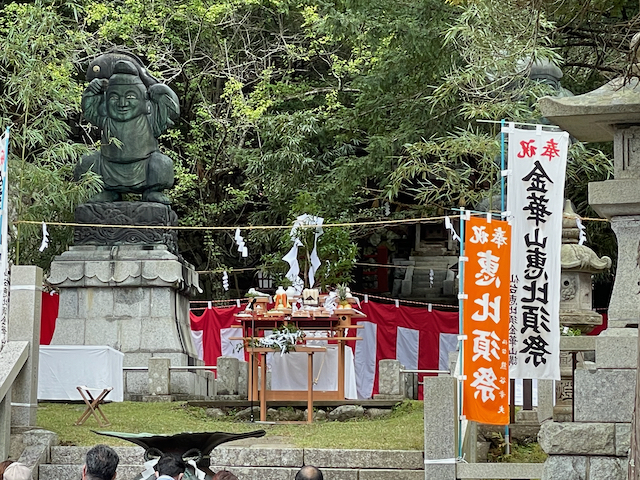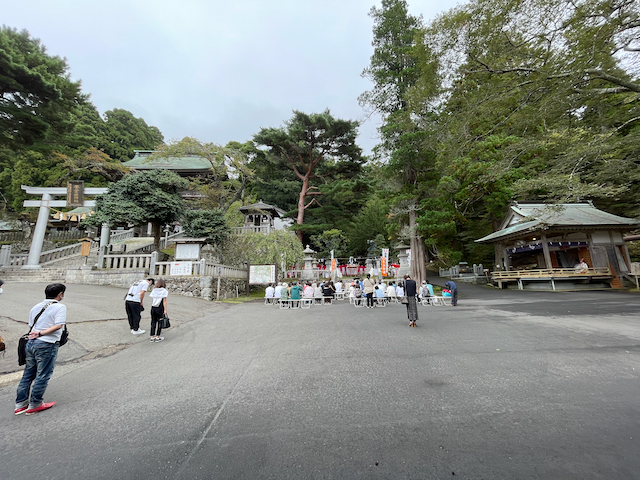Last Sunday, I went to Kinkazan Koganëyama Jinja, in Miyagi Prefecture, for a formal prayer. This is a jinja that I have visited every year for the last nine years, and I have mentioned it before on this blog — my name is literally carved in stone in the precincts. This year, for various reasons, I wasn’t sure that I would be able to get there, because it is a long way away, and last Sunday was when I could. By chance, that was also the day of the annual Ebisu Matsuri.
The main kami of the jinja are Kanayamahiko and Kanayamahimë, male and female kami associated with mining, as their names mean something like “Metal Mountain Prince” and “Metal Mountain Princess”. This, and the historical existence of gold mines in the area, has led to an association between the jinja and financial prosperity. Indeed, there is a tradition that if you visit the jinja for three years in succession, you will never be in financial need again. (So far, so good.) In popular belief, that seems to have been turned into “you will become rich”. (Less luck with that one.)
This possibly explains why there are large statues of Daikoku and Ebisu at the base of the stairs to the main sanctuaries, where an annual matsuri is performed for each kami. Daikoku and Ebisu are two of the seven kami of good fortune (another, Benzaiten, is also enshrined on the island, and of great importance to the jinja’s practice), and are both associated with financial success: Daikoku originally with farming, and Ebisu with fishing. These two kami were extremely popular historically, and are also enshrined at other jinja. Daikoku is normally identified with Ōkuninushi, although he is originally Chinese, and was imported through Buddhism. Ebisu is native Japanese, the only one of the seven kami who is, but has a name that means “foreigner”, and is identified with several different kami in different jinja: Sukunabikona, Kotoshironushi, and Hiruko are the three most common. Koganëyama Jinja appears to identify Ebisu as Kotoshironushi.
I wasn’t able to attend the whole of the Ebisu Matsuri. Koganëyama Jinja is on an island, indeed it is basically the only thing on the island, and you have to get a boat from the mainland. To get there early enough to have a formal prayer without staying overnight, I have to take the boat from Onagawa, which only gives you two hours on the island. That’s not enough time to attend the whole of the Ebisu Matsuri and have a ceremony performed at the main jinja, so I watched the first part of the Ebisu Matsuri, and then went off to have my ceremony performed (along with a group of other people).

There are a number of points of interest about the Ebisu Matsuri. The first is that it is held in front of a visible statue of the kami. This is extremely unusual in Shinto. It is not that uncommon for the goshintai, the object said to house the kami, to be a statue, but such statues are never visible. And, indeed, the statue of Ebisu does not, at least not normally, house the kami. This was made clear by the fact that the matsuri started with the calling of the kami, implying that Ebisu was not believed to already be present. Further, as the offerings are placed in front of a himorogi (the tree branch with white paper on it), that suggests that the kami is thought to inhabit the himorogi, not the statue, even during the matsuri. Nevertheless, people do pay their respects to the statues at other times. As usual, I suspect that trying to work out the detailed theology here is a fool’s errand.

The matsuri also involves an offering of kagura, sacred dance, but it appears that this takes place in the kagura-den (“sacred dance hall” is an accurate translation, but sounds very odd to my ears). As you can see in the wide-angle photograph, this is off to the side of the area in which the matsuri is performed, outside the area marked off as sacred. (It is to the right of the photograph; if you look carefully, you can see the miko sitting there, ready to dance.) Now, I had to leave before the dance started, so it is possible that it was held in the matsuri area, but I very much doubt it. The dance may be a special one but, as I said, I wasn’t able to see it.
I think that this jinja is worth a visit if you are interested in Shinto, although there is nothing else on the island, so I don’t recommend it if your interest in Shinto is entirely casual. However, it is a five-hour journey from Tokyo station to the island, involving three trains and a boat — and I am not sure you could reserve seats on the boat in English. It doesn’t see many foreign tourists, and it is easy to understand why.
Excellent article. I had planned on visiting Kinkazan as part of a trip through the Tohoku region in the summer of 2011, but the earthquake/tsunami forced a change of plans. I’m glad to see it’s still possible to visit the shrine.
It is indeed. I first went in 2013, when it was just barely possible, particularly for people like me without a car. Now, it’s really quite straightforward; the trains are running to Onagawa, and the boats from Onagawa are back on a regular schedule. The bus schedule to Ayukawa has got even worse than it was, however.